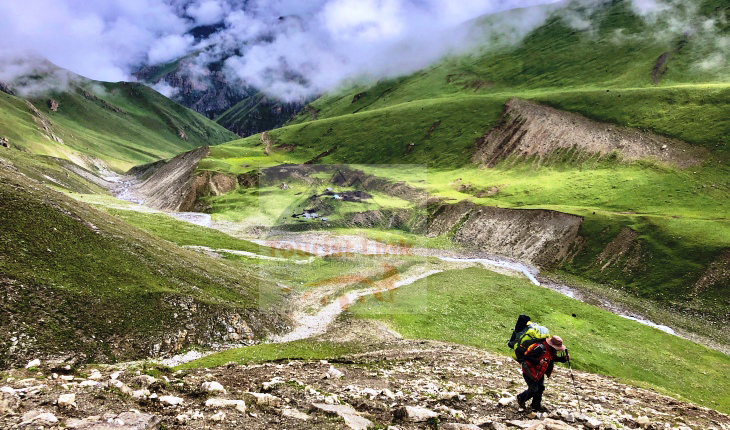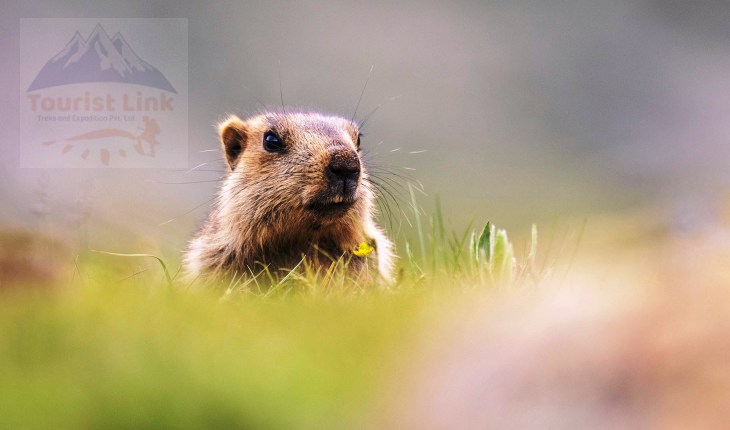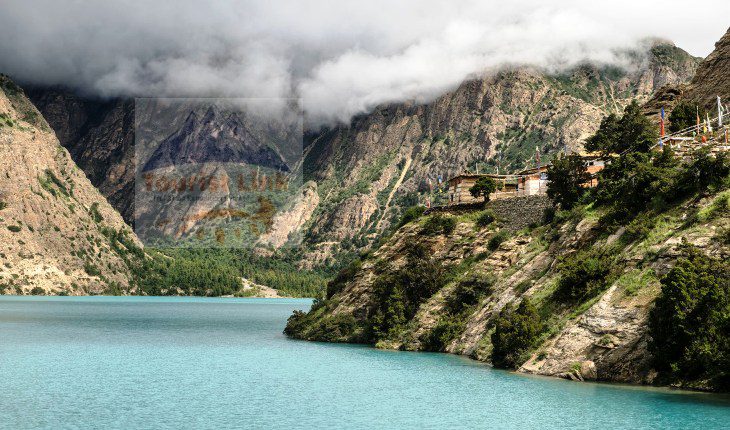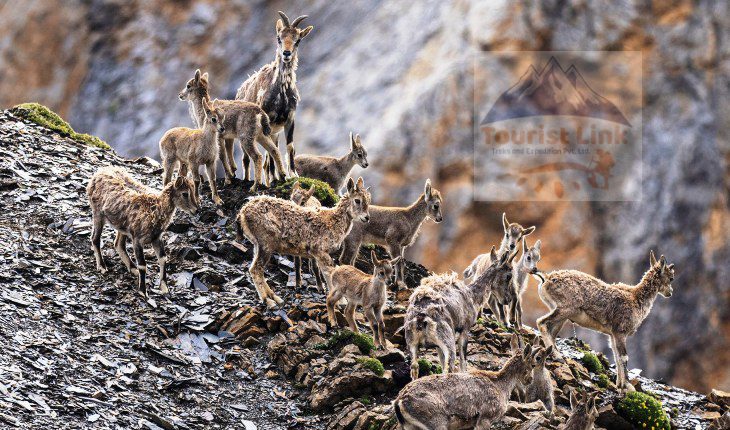Trip Facts
+2 People above
Moderate
Hotel/Guest House/Tented Camp
5350 M
B/L/D
Private Vehicle/Flight
Trip Highlights
- Tour Sightseeing at Kathmandu Valley with an experience tour guide (Kathmandu Durbar square, Swyambhunath, Boddhanath, Pasupatinath Temple.
- Himalaya scenic flight to Napaljunga to Jumla.
- Breathtaking view of Dhaulagiri range (8167m), Annapurna range (8091m), Nilgiri (7061m) and other more Himalaya.
- Lead by an experience mountain local guide who have best knowledge of the Upper Dolpo.
- Visit Shey- Phoksundo Lake (3733m), Shey Gompa Monastery (4500m) and several highland villages.
- Explore Culture, Custom, Monuments, tradition, Geography, Demography and flora-fauna.
- Nepali cuisine and local food.
- Learning Nepali Language and cooking.
Trip Overview of Upper Dolpa Trek
Known as the best Western Nepal Trekking, Upper Dolpo Trek is the Restricted Area Trekking into the isolated lands of the Dolpa Region which are located to the north of Dhaulagiri Range in Western Nepal. The region was officially opened to foreigners for trekking only in the year 1989. As Dolpa Region remained curtained to the outer world, it is able to preserve its ancient culture and traditions. In fact, Dolpo is among few regions where ancient Bon Po religion and shamanism are still in practice. Entering Shey Phoksundo National Park which is the largest National Park of Nepal, has Himalayan Wildlife View of snow leopard, musk deer, and Himalayan blue sheep, mounting the High Passes, enjoying the scenic views of Dhaulagiri Range, Annapurna Himalayan Range, Kyangyu Ripa, Kanjorowa Mountain, and Nilgiri Mountain, making a visit to crystalline blue Shey- Phoksundo Lake, visiting Shey Gompa Monastery and walking through several highland villages with an opportunity to get acquainted with the rural way of living are the major attractions of Upper Dolpa Trek.
‘Upper Dolpa Trek’ at Tourist Link Treks & Expedition’ is a 24 days adventure itinerary that begins with a pleasant flight to the trade city of Nepalgunj from where we will take the connecting flight to Jumla. The sensational trekking experience gets started at Jumla as we make progress through the meadow with lush green vegetation at Gothichaur and walk through the village to cross the high pass of Maria Lagna and Kagmara La which further leads us to the crystalline blue Shey Phoksundo Lake. Later, we will visit Shey Gompa Monastery before passing through a few villages to arrive at Juphal from where we will take a plane back to Kathmandu via Nepalgunj and thus the gratifying ‘Upper Dolpo Trek’ concludes.
Itinerary
Day 01: Arrival in Kathmandu
30 Min. Only Breakfast Hotel Kathmandu
Upon landing at the Tribhuvan International Airport in Kathmandu, you will be greeted by our representative from Tourist Link Treks & Expedition who will then convey you through the vibrant streets in Kathmandu to the hotel where you will receive a brief explanation regarding your trekking package. You will spend a pleasant night in the comfy bed.
Day 02: Sightseeing in Kathmandu
6 hrs Only Breakfast Hotel Kathmandu
Taking light breakfast early in the morning, our guide will then take you for a pleasant day tour inside Kathmandu which encompasses the UNESCO enlisted sites like the holiest shrine of Shiva at Pashupatinath Temple Complex, the Bouddhanath Stupa, and Swayambhunath Temple aka Monkey Temple. The tour will conclude by taking you to Kathmandu Durbar Square which is a historical site. Home of Living Goddess- Kumari, Kasthamandap Temple, and Kal Bhairab are some must-see sites around Kathmandu Durbar Square.
Day 03: Kathmandu - Nepalgunj
30 Min B/L/D Hotel Nepalgunj
An hour-long flight with a beautiful aerial view of mountains and terraces will lead us to the western central hub of Nepalgunj. Positioned in Western Terai, Nepalgunj is located near the Indian border which makes it an important trade center for Nepal.
Day 04: Fly to Jumla Trek to Gothichour
40 Min B/L/D Guest House
About 35minutes of scenic flight from Nepalgunj will take us to Jumla. The gratifying trekking experience gets triggered in Jumla as we make our way to Tila Khola and pass along its confluence to Chaudabise. From Chaudabise, we will follow the raised path through terraces and woods to the plain land at Gothichaur.
Day 05: Trek to Napakhola
5 -6 hrs B/L/D Mountain Lodge
We will begin our trek early in the morning. Walking along Tila Khola, we will walk past the fields of corn, buckwheat, barley and potatoes from where the trail stretches through the Maniwals to the pretty small Buddhist Village of Napakhola which will bless us with an opportunity to familiarize ourselves with the culture and ways of living of friendly locals.
Day 06: Trek to Balasa through Mauria Lagna pass
5-6 hrs B/L/D Mountain Lodge
Leaving Napakhola early in the morning, we will follow the steep trail which will lead us to the forest of oak and rhododendrons. Later, we will choose the raised path to Mauria Lagna also known as Honey Pass. Enjoying the scenic views of valley from the top, we will take a downward trail through Chaurikot Village to a river from where the trail escalates uphill to the ridge at 3080m. Balasa exists about 30 minutes far from the ridge.
Day 07: Trek to Hurikot
5-6 hrs B/L/D Mountain Lodge
Trekking on the 7th day begins immediately after having a light breakfast. We will make an advance through the trail that escalates uphill. The path progresses through thorn bushes to eventually arrive at Hurikot. It takes about 6 hours duration to complete the journey to Hurikot which is located at 2835m altitude height.
Day 08: Trek to Kagmara Phedi
5-6 hrs B/L/D Mountain Lodge
The trail on this day begins getting steeper. Following the trail, we will arrive at the rough terrain of Kagmara Phedi which is considered the basecamp for Kagmara. We will be staying overnight at the foothill of Kagmara La as the next day, we will be having a bit difficult ascent of Kagmara La.
Day 09: Trek to Pungmo via Kagmara La
5-6 hrs B/L/D Mountain Lodge
Climbing alongside the Kagmara Glacier, we will ascend through the bit strenuous trail towards the apex of Kagmara La where we will enjoy the scenic views of mountains from the summit before taking a downward trail to Pungmo Khola from where we will follow the trail that offers the gratifying view of Kanjirowa peak to Pungmo Village.
Day 10: Trek to Phoksundo Lake Trek to Pine trees
5-6 hrs B/L/D Mountain Lodge
Moving further ahead, we will arrive at an entrance of Shey Phoksundo National Park in Suduwa from where we will make progress to Shey Phoksundo Lake. Indulging ourselves in the beauty of the crystalline water of Shey Phoksundo Lake, we will pass through the cascading waterfall to Pine Forest where we will be staying overnight in a camp.
Day 11: Trek to Gand La Base camp
5-6 hrs B/L/D Mountain Lodge
The trekking on 11th day begins early in the morning. It takes about 6hours of walking through the streams, woods and a valley to arrive at Gand La Base Camp where we will be staying overnight.
Day 12: Trek to Shey Gompa
5-6 hrs B/L/D Mountain Lodge
Shey Gompa which is also known as ‘Crystal Mountain’ is the Bonpo monastery which locates itself at an altitude of 4500m height in the most isolated part of Dolpo where the locals still practice shamanism. Shey Gompa Monastery was built around 800years back and it belongs to Chaiba community.
Day 13: Trek to to Lagmo Che Phedi
5-6 hrs B/L/D Mountain Lodge
Leaving the wonderful Shey Gompa premises, we will move further to Lagmo Che Phedi. Lagmo Che Phedi is a high camp destination that exists below the Jeng La pass on the northern side between Saldang and Dho Tarap. We will stay overnight in a camp at Lagmo Che Phedi.
Day 14: Trek to Kyung La Base Camp
5-6 hrs B/L/D Mountain Lodge
Kyung La Base Camp exists near Shering Gompa and it demands a special permit to step into the land of Kyung La base camp. We will have a strenuous trek with scenic views that passes through dispersed settlements to arrive at Kyung La Base Camp where we will be staying overnight.
Day 15: Trek to Tokkyu village
5-6 hrs B/L/D Mountain Lodge
About 7 hours of walking will be enough to shift us from Kyung La Base Camp to the Tokkyu village. The pleasant trekking begins with an ascend to the summit of Jeng La Peak from where we will follow the downward trail towards the pretty small highland village that is known as Tokkyu Village.
Day 16: Trek to Dho
5-6 hrs B/L/D Mountain Lodge
Continuing through the trail that lowers down, we will walk past a huge mani wall to make it to the Tarap region. Advancing further through the barley fields, we will eventually arrive at the village of Dho where we will be staying overnight.
Day 17: Trek to Tharap Khola
5-6 hrs B/L/D Mountain Lodge
Leaving Tarap Valley, we will chase the trail that lowers down through the wide valley to a gorge. A brief trek through juniper bush and wild rose will lead us to the confluence of Tarap Khola and Lang Khola which is popular among locals as Kamakharka. We will pitch our camp at the bank of Tharap Khola.
Day 18: Rest Day in Tharap Khola
5-6 hrs B/L/D Mountain Lodge
It is taken as the rest day. We will be preparing ourselves for the trekking to be done in the upcoming days. If you are interested, we can arrange a short hike to a nearby village which will allow us to be acquainted with the rural way of living.
Day 19: Trek to Tarakot
5-6 hrs B/L/D Mountain Lodge
From Lahini, we will make an advance through the wide Valley where the Laskap River meets with Tarap Khola. Progressing further, we will make it to Kamigoan village which is located at 2950m altitude. Kamigaon Village is the winter residence of people from Tarap village. Walking down to the river, we will reach to the Barbung Khola from where we will reach the Tarakot Village.
Day 20: Trek to Dunai
5-6 hrs B/L/D Mountain Lodge
Continuing our journey through Barbung Khola, we will move through the southern edge of Laban Village to Dabung which further leads us to Dunai which is the district headquarter of Dolpa. We will be staying overnight in Dunai.
Day 21: Trek to Juphal
5-6 hrs B/L/D Mountain Lodge
We will follow the short and easy trail all the way to Juphal which is located at 2345m altitude height. Since we will be catching the plane from Airport at Juphal only the next day, we will stay in a lodge at Juphal for the night where we will be busy packing things for our departure to Nepalgunj and to Kathmandu.
Day 22: Flight Juphal - Nepalgunj – Kathmandu
1 hr Only Breakfast Kathmandu
A brief yet pleasant flight of about 30 minutes duration from the airstrip at Juphal will take us to Nepalgunj. We will then board another plane from Nepalgunj to Kathmandu.
Day 23: Free day in Kathmandu
All Day Only Breakfast Kathmandu Hotel
This is taken as a leisure day. You can take a stroll around the freak streets of Thamel where you can select from a wide range of handicraft goods and other gift items to take along with you as a memoir of Nepal. A rickshaw ride especially in the evening will be fun.
Day 24: Departure
30 Min Only Breakfast
The wonderful 24days ‘Upper Dolpa Trek’ comes to an end on this day as you will be transferred back to Tribhuvan International airport by our representative. We are happy to serve you and we will be looking forward to your next visit.
What's included?
- Airport pick up and drop off by private vehicle
- Sightseeing at Kathmandu Valley (Monkey Temple, Pasupapati Temple, Boudhanath, Durbar square)
- Two-night accommodation with breakfast at 3-star category Hotel in Kathmandu
- Best available twin-sharing lodge for accommodation during the trek
- All domestic Airfare (Kathmandu – Nepaljung – Jupal - Kathmandu)
- All ground transportation on a comfortable private vehicle and deluxe bus as per itinerary
- Three daily meals (Breakfast, Lunch, and Dinner) during the trek
- One highly experienced helpful and friendly guide (English speaking and Government licensed holder guide)
- Porter service (2 Trekker: 1 Porter) their food, accommodation, Salary, equipment, and staff insurance
- Snacks of seasonal fruits during the trek
- Down jacket and sleeping bag (to be returned after trip completion)
- Trekking map and trip achievement certificate
- All necessary paperwork and permits (Restricted area permit and ) please bring 3 passport-size photographs
- All Local/Government Taxes and office service charge
- Medical Supplies (First Aid Kit will be available)
- Arrangement of Emergency Helicopter service which your travel insurance Company will pay.
What's not included?
- Nepal Visa fee
- Meal not specified in the “meal inclusions” in the above itinerary
- Personal trekking equipment
- Snacks and other expenses
- International airfare to & from home town
- Excess baggage charges
- Hot showers during the trek except when in Jupal
- Personal travel insurance
- Personal expenses like phone calls, laundry, bar bills and extra porters
- Tips and donations for guides and porters.
- Optional trips and sightseeing if extend
Fixed Departures
Essential Information
When to Go?
March to May and mid-September to November are ideal times to go on trekking in Nepal. However, you can do the trek throughout the year, excluding harsh winter and heavy monsoon period for better experiences. Read more...
Gear Checklist
Gears and equipment assure your safety and smooth trekking experiences as you enter the Himalayas. With essential equipment, you can add some of the other specific ones which most probably will come handy in the trek. A reliable preparation from your side is a positive step for successful trekking and climbing expedition. Read more...
Food, drinking water, and accommodation facilities
The menu for everyday foods gets slimmer with a significant rise in altitude. One can always find a warm tea and basic local staple in the lodges or teahouses operating here. Natural drinking water sources, as well as Drinking water taps, are available throughout the trail. Accommodations might lose even some of the basic facilities as we move higher up in the trails of Himalayas. Read more...
Trip Permit
To enter and trek the protected and restricted segments of Nepal, you will have to take special permits from the government of Nepal for the sole purpose of preserving the people and nature of these areas. Read more...
Altitude Sickness
Altitude sickness is one of the primary concern while trekking in the areas of higher altitude. You must be prepared and act quickly if the symptoms appear during the trek. Using some prevention techniques, you can slow down and minimize the symptoms of Altitude sickness up to some extent. Read More...
Physical condition and experience requirements
Different types and levels of trekking might require a certain minimum fitness level to accomplish. With the guides, you can make up for the segments of lacking experience of trekking. Nepal also offers a lot of different varieties of the trek which the trekkers of any age or physical condition can do. Selection of optimal trekking program is best for both parties. Read more...
Weather
Weather in the Higher Himalayas is always unpredictable. Regular monitoring and contact help us to be safe from any unforeseen change of weather in most cases. With the presence of a licensed guide, you can take correct destinations and make the most of the trek. Read more...





